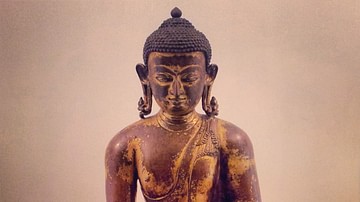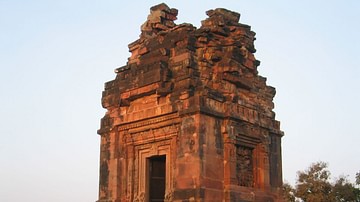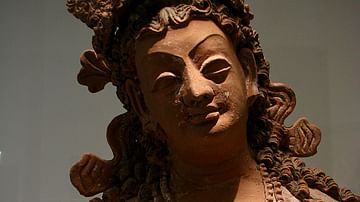
Approximately 67 miles (107 km) to the north of Aurangabad in the Indhyadri range of Western Ghats lie the caves of Ajanta. The 30 caves, famous for their early Buddhist temple architecture and many delicately drawn murals, are located in a 76 m high, horseshoe-shaped escarpment overlooking the Waghora (tiger) River. The river originates from a picturesque waterfall called sat kund (seven leaps) just off the last cave. It serves as a potent reminder of the natural forces that over untold eons have shaped the basaltic layers of the Deccan plateau. Also a part of the Gautala Wildlife Sanctuary, this primordial landscape provides a fitting background to one of the finest collections of paintings from India's antiquity.
Accorded UNESCO World Heritage site status in 1983 CE, the ancient name of the site is untraceable today. Its current name is derived from a neighbouring village, the local pronunciation of which is Ajintha. It would be of interest to note, that Ajita is the colloquial name of Maitreya Buddha.
Timeline & Patronage
The period of excavation (used as synonymous to the carving of the caves) can be divided into two broad phases. The earliest caves (Cave 8, 9, 10, 12, 13, 15A), belonging to the Hinayana phase of Buddhism, can be roughly traced back to the 2nd century BCE, with its period of activity continuing to around the 1st century CE during the rule of Satavahana Dynasty (2nd century BCE – 2nd century CE). The later phase of activities, between 5th and 6th century CE, largely took place under the patronage of the Vakataka dynasts (3rd century – 5th century CE). The Vakatakas were contemporaries of the Gupta Empire. The greatest flourish of this phase took place during the brief but remarkable reign of the Vakataka Emperor, Harisena (460 CE - 477 CE). By then the “mythologising tendency of Indian thought” (Coomaraswamy) had already given birth to Mahayana Buddhism from more austere Hinayana practices.
The excavation and creation of the caves seem to have been a more community effort in the earlier phase. Group efforts contributed to the building of various parts of the caves, from the façades to single cells. Later, however, construction was marked by sponsorship from influential patrons and local feudatories. Inscriptions from Caves 4, 16, 17, 20, and 26 indicate that often multiple caves were constructed under the benefaction of one patron; examples would include local Risika king Upendragupta, Harisena's Prime Minister Varahadeva, and the Asmaka monk Buddhabhadra. Royal patronage did not, however, restrict its accessibility to an exclusive clique. Thus, despite being a Shaivaite emperor (at least at the time of accession to throne), Harisena presided over the execution of some of the finest depictions of Buddhist legends.

Location & Layout
While the peaceful surroundings may be self-explanatory of the initial choice of a Buddhist monastic establishment, the caves also lay close to the ancient trade routes and capital of the Satavahana Empire, Pratishthana (currently Paithan, 130 km south of Ajanta). The rule was benevolent, commerce flourished and the cities prospered. Buddhism was already popular and Buddhist bhikshu (monks) travelled across the Deccan plateau as emissaries following Mauryan Emperor Ashoka's (304 – 232 BCE) energetic patronage.
The caves of Ajanta were not excavated in isolation, but a range of similar activities resulted in a number of cave complexes across the Western Ghats. Some of these include the caves of Karli, Bhaja, Kanheri, Junnar, Nasik, Kondana, and Pitalkhora. It is quite possible that the inspiration for such rock-cut caves came from a set of similar structures in Barabar and the Nagarjuni Hills located in the Jehanabad district, 24 km north of Gaya. These were built during the reign of Ashoka and his grandson Dasarath (232 – 224 BCE), who succeeded him to the throne.
The permanence of rock-cut architecture compared to the prevailing free standing wooden structures and locational advantage of such dwellings were powerful arguments in favour of these experiments. The cave complex in Ajanta comprises 30 caves. Of these, five (9, 10, 19, 26, and 29) are chaitya (prayer hall with a stupa at the far end) and the rest are vihara (monastery). The caves are numbered according to their relative arrangement along the horseshoe-bend in an anti-clockwise manner from the outer end and not as per the time of excavation or purpose.

Paintings of Ajanta
The Ajanta murals, owing to their inherent fragility and an abundance of destructive natural and maleficent human agents, have suffered considerable damage, often irrevocably so. Despite the depredations, the excellent craftsmanship (specifically in Caves 1, 2, 16, 17) shines through the defiled and blackened surfaces even today. The narratives flow unrestricted from one cave wall to the next with effortless flexibility. Deep understanding of nature and profound compassion infuse each stroke and every gesture with ardour and tenderness that produces an indelible impression in the heart and mind of the beholder. It is a world of graceful movements and “serene self-possession” (Coomaraswamy) far removed from personal art of modern time. Brought to life by nameless artists, the murals trace the atman (soul) beyond verisimilitude and transient emotions, mirroring the collective social psyche.
It would be erroneous to consider that all paintings were rendered uniformly. For there are variations of style and work of minor hands comingle with chef-d'œuvre. And yet the poise, poignant faces, and expressive gestures bear infinite significance. This includes those hand signals known as mudras which are core to yoga, meditation, and Indian dance drama.
The art of Ajanta is that of a school. It is important to remember that pursuit of art for art's sake did not constitute the sole aim and search for beauty was not an end in itself. The great religious art of Ajanta through all its sincerity and refinement acts as crucial markers towards the journey within.
Painting Technique
The rugged surface of the cave walls was made further uneven to provide a firm grip to the covering plaster made of ground ferruginous earth, rock grit, sand, vegetable fibres, paddy husk, and other fibrous materials of organic origin. A second layer of mud, ferruginous earth mixed with pulverised rock powder or sand and fine vegetable fibre helped to cover the whole interior of the cave. The surface was then treated with a thin coat of limewash over which pigments were applied. Except for the black which was obtained from kohl, all other pigments were of mineral origin. Terra verda or glauconite for green, lapis lazuli for blue, kaolin, gypsum or lime were of frequent use.
One of the peculiarities of the murals in Ajanta is that the power of expression depends chiefly on the swiftness of its outlines. The bold, sweeping brushstrokes portray an intimacy and sensitiveness that, even though the original lustrous colours have all but faded, reveal these to be works of adept minds and assured hands.

Painting Subjects
Jataka tales, consisting of narratives related to different incarnations of Buddha, form an abundant wellspring for a magnificent project of the scale of Ajanta. The quaint humour, distinguished gentility and earnestness which characterise this lore was a part of an oral tradition and followed irrespective of creed or allegiance. Their extensive adoption in Ajanta demonstrates an already wide acceptance among priests and populace alike.
As Buddhism evolved from earlier Hinayana to Mahayana faith, the depictions and paintings transformed. In Caves 9 and 10 the Enlightened One was represented only symbolically by the Bodhi tree, paduka (wooden footwear), wheel etc. and not pictorially. In the later phase of the development, deeply influenced by Mahayana Buddhism, murals recruit a venerable pantheon of celestial beings including Kinnara, Vidyadhara, and Gandharva among others. Ajanta then appropriately presents us with a cornucopia of beliefs, intellectual atmosphere, culture, institutions, economy, adventures, and the ways of the masses and nobility over half a millennium and more.
Sculptures of Ajanta
The parallels between the murals on cave walls and sculptures and sculptural motifs that adorn Ajanta are manifold. Both undergo a remarkable transformation during different phases of development, both draw inspiration from magnanimous Jataka tales, and both are equally eloquent through expressive gestures or lack thereof. Buddha as the seated yogi is the epitome of repose and stability and Buddha in abhaya mudra encourages dignified self-assurance. Besides seated forms, standing poses of no less variation and significance abound, for such subtle movements of hands and limbs communicate the impelling thought itself much more than the subsequent performance or act. So the Indian imager made extensive use of these gracious movements for a powerful impact.
Hinayana Buddhism with its rationalistic philosophy and express prohibition of pictorial depictions of Buddha could not have inspired a metaphysical art comparable to the grandeur of the later phase. So, beyond symbolic motifs and stupa (of Caves 9, 10), little sculptural activity is observed in the caves excavated in the earlier phase.
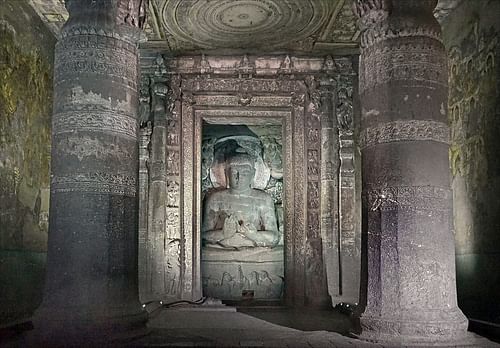
Sculptures in Ajanta were both plastered and painted though any trace of the latter is invisible to the naked eye today. The garbha griha (sanctum sanctorum) of each vihara contains almost invariably in seated posture the figure of Buddha in dharma chakra pravartana mudra (Buddha in preaching attitude delivering his discourse). The colossal figure of Buddha in Cave 26 or the statues of Buddha that flank the entrance to Cave 19 showcase versatility in scale and narrative structure which is equally supported by delicate features and delineated forms. The façade of Cave 19 with its intricately carved pillars and pilasters, decorative motifs on rows of chaitya arches and other structural peculiarities are wonderful examples of the unison of sculpture and architecture into a harmonious whole.
Architecture of Ajanta
Much like the murals and sculptures, architectural elements too evolved continuously under differing influences and motivations. In as much as Ajanta was an application of hereditary knowledge, it was also informed by a process of constant discovery and learning, incorporation of new ideas and forms from other sites such as Bagh, and an ever-evolving artistic vocabulary. The architecture of the cave complex is unique because it reflects the ever-improving proficiency of the craftsmen, educated in an architectural style already highly developed but unfamiliar with the rock-cut medium. Ajanta in its full flourish, therefore, represents a successful integration of the splendour of contemporary structures with the peculiarities and potentials of the basaltic medium.
As previously alluded to, there are five chaityas in the cave complex with the rest being vihara. A chaitya is apsidal or rectangular in form with aisles on either side of a nave with a barrel roof. Each aisle is separated by a row of pillars. The nave contains a stupa, the object of worship, at the terminal end. The early chaityas meticulously imitated contemporary wooden structures as can be seen in the vaulted roof decorations and pillars.
In contrast to the early stupas of Caves 9 & 10, those built at later dates such as in Caves 19 & 26 have an image of Buddha sculpted on the front face. Another distinguishing feature of Cave 10 is its giant single-arched entrance and relatively unadorned façade which gives way to a smaller doorway with a window positioned above. Skilfully decorated façades and pillared porticoes testify to a definite shift in architectural activities from early austerity.
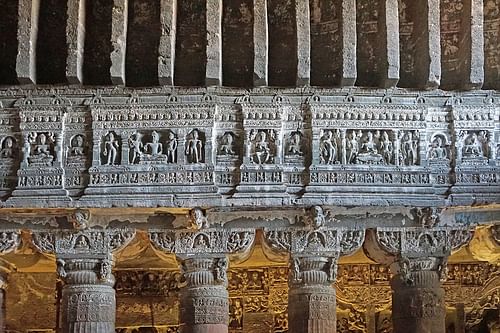
A vihara, otherwise called sangharama, was a monastic abode consisting of a central hall with adjoining residential cells. Caves 1 & 17 may be taken as the most representative example of a vihara in full development. A pillared porch or verandah with elegant embellishments leads to a commodious central hall, somewhat squarish in plan with cells for monks hewn into its sides. Further on, an antechamber connects to the garbha griha containing an image of Buddha. Thus, it can be said that architectural development proceeded from early sober, even restrained, astylar form to ambitious, richly ornamented pillared viharas.
Natural weathering agents and scarp retreat in the order of 5-7 m over the centuries have left their devastating impact on the frontispiece of many of the caves and managed to eliminate all of the stairs (except some below Cave 17) that connected each cave to the stream below.
Fall of Ajanta
The sudden discontinuation of activities in Ajanta inevitably coincides with the untimely death of Vakataka Emperor Harisena. But the seeds for disruption were sown much earlier. The provinces of Asmaka to the south of Ajanta, Anupa (where Bagh caves lie) to the north, and Risika, which included Ajanta, were inherited domains of Harisena; he did not have to conquer them. This explains the fact that within a few of years of his accession to the throne excavation work started at the site under the patronage of different vassals. It is not hard to surmise that the situation was relatively peaceful for the neighbouring rulers, despite having a belligerent history, as they came together to sponsor the projects at the same site.
This, however, did not last for long. By early 469 CE, Asmaka started a fierce battle with Risika lords. All work at Ajanta had stopped by 472 CE, and this suspension continued until late 474 CE when the Asmaka emerged victorious from the battle. From then on until the sudden death of Harisena in late 477 CE, much effort was afoot. With the passing away of the emperor, the golden years of Ajanta, too, came to an abrupt end; as chaos reigned supreme under an inept successor, violent conflicts broke out over regional supremacy, and the Vakataka Empire imploded spectacularly.
By 480 CE all excavations had ceased, most of the patrons had either been dethroned or dispossessed from their seat of power. From the sounds of chiselling and chanting, life had almost returned to a primaeval silence interrupted only by the chirping of birds or chattering of monkeys. After all, the later phase of growth at Ajanta was driven by a dozen or even less courtly patrons hoping to carve out a monument of magnificent proportions and beauty. Unlike the earlier era where it was a community effort that laid the foundation of Ajanta, this second outpour was bound to dry up with the change of fortunes of its handful of donors. In the end, what instigated its rapid expansion also forced its sudden abandonment.
After a gap of many centuries, Ajanta is again thriving with travellers, scholars, and devotees alike from across different continents. Though it no longer serves the purpose for which it was originally built, it has something to offer anyone who can spend a few moments in quiet contemplation indoors. In conclusion, the following words of renowned German archaeologist Ernst Walter Andrae (1875-1956 CE), to be found in Keramik im Dienste der Weisheit, can be used to aptly describe the significance of the art of Ajanta: "It is the business of art to grasp the primordial truth, to make the inaudible audible, to enunciate the primordial word, to reproduce the primordial images – or it is not art."


